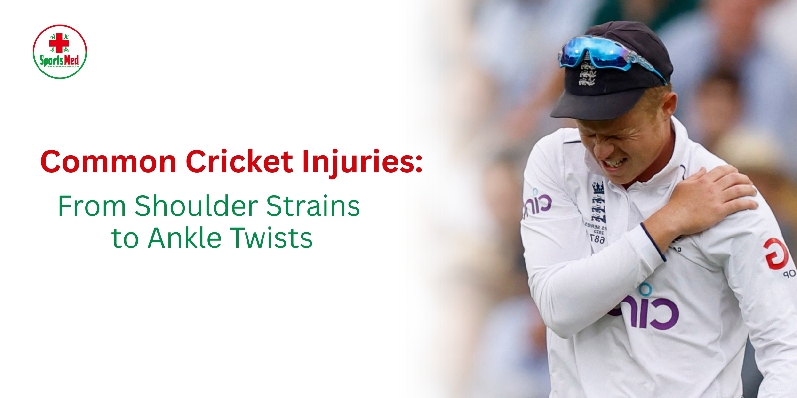
Common Cricket Injuries: From Shoulder Strains to Ankle Twists
Cricket is a blend of explosive power and relatively stationary physical activity. Setting the record straight, mobility caused by a drive of power that ranges from hurtling fast bowlers with a downward delivery cannot be compromised by this sport. Injuries from fielding shoulder strains to ankle twists while running between wickets can ruin performances or bench players for entire seasons. Both amateur and professional players should be aware of the most common cricket injuries and how to prevent them.
Why Injuries Occur in Cricket: 10 Common Reasons
Injuries sustained in cricket are from repetitive stress, technical faults, or inadequate preparation. Here are the top 10 reasons for injuries in cricket:
1. Overuse and Repetition: At one time or another, the fast bowler may consider himself to be a medium pace bowler, thereby choosing a bowling action to be used several hundred times in imparting varying degrees of wear and tear to the joints and muscles.
2. Improper Warm-Up: The absence of prior stretching and warm-up exercises before practice or matches can stiffen the muscles and lead to injury.
3. Incorrect Method: Using the wrong technique in batting, bowling, or throwing can strain the joints and muscles, leading to potential injury.
4. Sudden Movements: Sudden changes of direction in fielding or diving often result in sprains and strains.
5. Fatigue: Coordination gets impaired when one is tired, thereby increasing the chances of an accident.
6. Poor Footwear: Shoes not designed properly will affect grip and stability, and, most importantly, balance while running on an uneven grassy surface.
7. Poor Ground Conditions: The uneven surfaces usually give way at the ankle with a nice little ankle twist; then slippery conditions play their part in launching the victim with a full drop.
8. Dehydration and Poor Nutrition: Matches are played for hours under the sun, and without proper hydration, cramping and heat-related injuries can occur.
9. Strength and Conditioning Deficit: A lack of strength in the core and lower-body muscles can lead to joint aches in the shoulders, knees, and ankles.
10. Insufficient Recovery Time: Your body is forced into more than one training session without sufficient rest; minor niggles can turn into major ones.
According to sports medicine studies, over 60% of cricket injuries are preventable with proper conditioning and training.
Most Common Cricket Injuries
Here are some injuries most commonly reported in each cricketing role:
1. Shoulder Strains and Rotator Cuff Injuries
Common injuries for fielders and bowlers are caused by repeated overhead throwing. Pain, weakness, and limited range of motion are typical symptoms.
2. Low Back Pain
Fast bowlers are particularly vulnerable to this due to repeated spinal axial rotation and high axial compression forces with impact. This has been documented from studies, as 45% of young fast bowlers suffer from lumbar spine stress injuries.
3. Hamstring Strains
Usually sustained during explosive motions such as sprinting between wickets or diving while fielding.
4. Knee Injuries
Patellar tendonitis and meniscus tears are common injuries associated with repetitive jumping and deceleration.
5. Ankle Sprains
Usually occur while turning quickly or awkward landings on uneven surfaces.
6. Finger Dislocations and Fractures
Risks associated with professions involved in such injuries include batters, wicketkeepers, close fielders, missed catches, or awkward landings.
7. Side Strains
More often seen in bowlers and involves an injury to the oblique muscles. Pain is felt during the delivery stride or the follow-through.
8. Tennis Elbow (Lateral Epicondylitis)
Caused by repetitive arm extension, especially in batters and bowlers.
9. Concussions
Ground collisions or accidents due to exceptionally fast bouncers are rare, but they can happen.
10. Wrist Sprains
These injuries occur to batters when a sudden twist of the bat or a mis-hit happens, and also to wicketkeepers during dives.
General Injury Prevention Tips for Cricketers
In short, prevention is better than a cure when it comes to an injury. These are some of the suggestions proposed by physiotherapists and sports coaches:
1. Warm Up and Cool Down
Enter dynamic stretches and light jogging before the game. Static stretching after a session helps muscles recover and prevents them from becoming stiff.
2. Strength and Conditioning
Develop your core, shoulders, and legs for enhanced strength. Do incorporate resistance training and balance drills.
3. Proper Technique and Coaching
Have certified coaches work on your bowling and batting techniques. Biomechanical assessments may help in eliminating undue strain.
4. Protective Gear
Wear helmets, thigh guards, elbow pads, and gloves at all times to cut down the force of direct hits.
5. Hydration and Nutrition
Stay hydrated and consume protein to support muscle repair and endurance.
6. Recovery and Rest
Rest days are necessary; there should be no back-to-back matches or extended practice sessions. Recovery tools, such as the foam roller and massage, can aid in recovery.
7. Regular Physiotherapy
Maintaining periodic physiotherapy and checkups, as recommended by Sports Injury Care, goes a long way in helping discover the actual cause of any issues before they take a serious turn.
Conclusion
While there are many kinds of cricket injuries, almost all can be avoided through proper training, good knowledge, and adequate support. Whether you are a bowler carrying some back pain or a batsman nursing an accidental sprain on his wrist, the medical diagnosis and proper rehabilitation are necessary to stay fit throughout one's life. Even in the case of the slightest pain, neglect can be translated into chronic injuries capable of bringing damage to a player's performance and confidence.
For the best kind of injury treatment and prevention, you could look for Sports Injury Care, where evidence-based treatment and athlete-centered rehab programs are brought together to empower cricketers to come out stronger and safer.